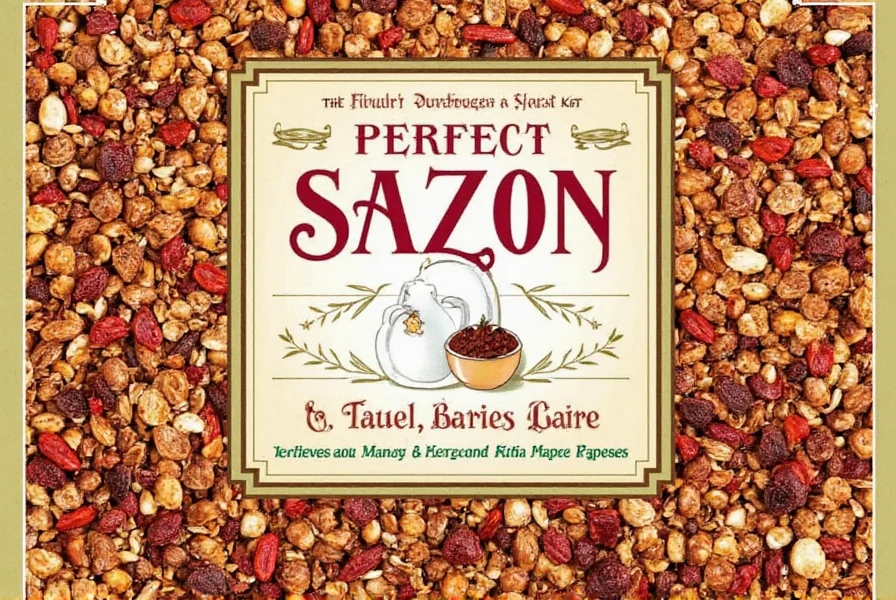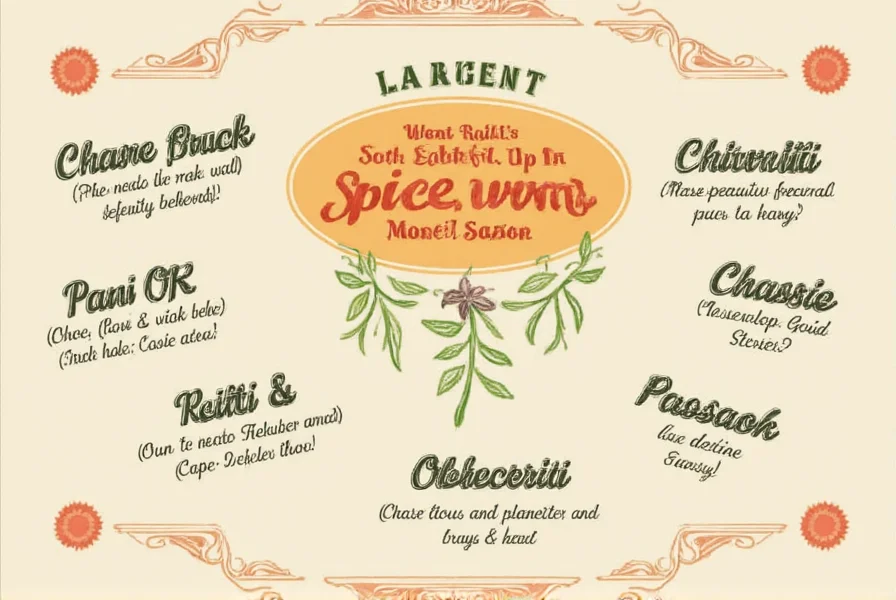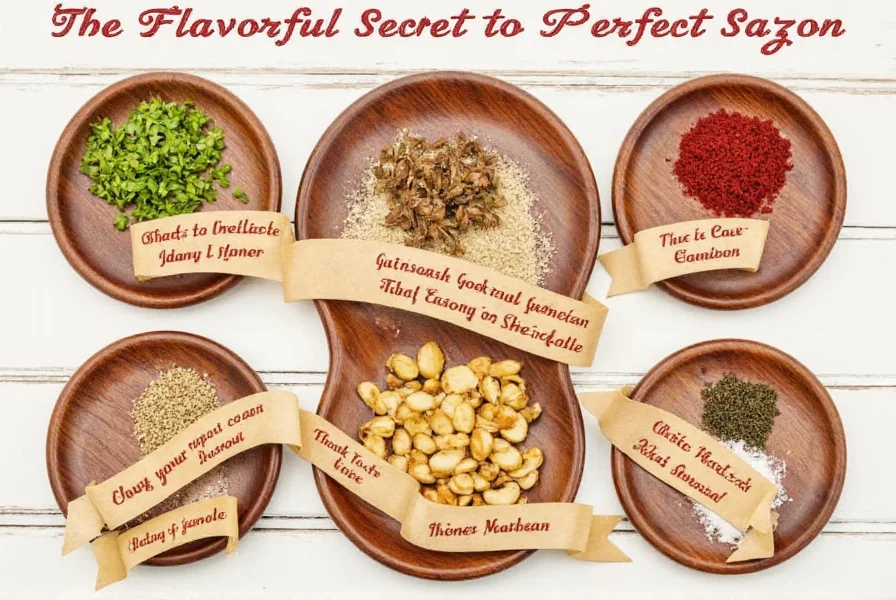Table of Contents
Sazon is a traditional Latin American seasoning blend commonly used in Puerto Rican, Cuban, and Caribbean cuisine. The primary ingredients in sazon typically include: annatto (achiote) for its distinctive yellow-orange color, cumin for earthy warmth, coriander for citrusy notes, garlic powder, onion powder, oregano, and paprika. Some variations may also include salt, black pepper, or other spices.

What is Sazon?
Sazon translates to "seasoning" in Spanish, but it's much more than a simple spice mix. This traditional blend has been used for generations in Latin American cooking to add depth, color, and authentic flavor to dishes. Unlike generic seasonings, sazon has specific characteristics that distinguish it from other spice blends.
The distinctive yellow-orange color of sazon comes primarily from annatto (also called achiote), which is a key ingredient that sets it apart from other seasoning mixes. This color is so characteristic that many people associate the bright yellow hue with authentic sazon.
Essential Sazon Ingredients
While regional variations exist, the core ingredients that form the foundation of traditional sazon include:
| Ingredient | Role in Sazon | Flavor Profile |
|---|---|---|
| Annatto (Achiote) | Provides distinctive yellow-orange color | Mild, slightly peppery, earthy |
| Cumin | Forms the base flavor | Warm, earthy, nutty |
| Coriander | Adds brightness and balance | Citrusy, floral, slightly sweet |
| Garlic Powder | Provides savory depth | Sharp, pungent, savory |
| Onion Powder | Enhances savory notes | Sweet, mild, umami |
| Oregano | Contributes herbal complexity | Rosemary-like, slightly bitter |
| Paprika | Adds color and smoky notes | Sweet, smoky, slightly spicy |
Traditional sazon typically does not contain bay leaf, which is commonly used whole in stews rather than ground in seasoning blends. Some commercial versions may include salt or MSG as additional ingredients, but authentic homemade sazon usually avoids these additives.

Practical Tips for Using Sazon
Using sazon effectively in your cooking requires understanding its characteristics and how it interacts with other ingredients:
- Start with small amounts: Sazon is potent, so begin with 1/2 to 1 teaspoon per pound of food and adjust to taste. You can always add more, but you can't remove it once mixed in.
- Use fresh spices: For homemade sazon, use recently ground spices for maximum flavor. Ground spices lose potency over time, so store them properly in airtight containers away from light and heat.
- Pair with complementary ingredients: Sazon works well with tomatoes, citrus, peppers, and beans. Avoid pairing it with delicate ingredients like fish or light vegetables that might be overwhelmed by the strong flavors.
- Use for specific dishes: Sazon is particularly effective in rice dishes (like arroz con pollo), stews, grilled meats, and beans. It's less suitable for delicate sauces or desserts.
- Make your own: Creating your own sazon blend allows you to control the ingredients and avoid additives like MSG or excessive salt that may be present in commercial versions.

Frequently Asked Questions About Sazon
What are the 3 most essential sazon ingredients for authentic flavor?
The three most essential ingredients for authentic sazon flavor are annatto (for the distinctive yellow-orange color), cumin (for the earthy base flavor), and coriander (for the citrusy balance). These three ingredients form the core of traditional sazon blends and distinguish it from other seasoning mixes.
What is the difference between sazon and adobo?
Sazon and adobo are both popular Latin American seasonings, but they serve different purposes. Sazon typically contains annatto for color and focuses on specific spices like cumin and coriander, while adobo is a simpler blend primarily made of garlic, oregano, black pepper, and salt. Sazon is often used for color and depth in rice dishes, while adobo serves as a more general-purpose seasoning for meats and vegetables.
Does traditional sazon contain MSG?
Authentic homemade sazon does not contain MSG. However, many commercial sazon packets (including popular brands like Goya) do include monosodium glutamate as a flavor enhancer. If you're concerned about MSG, making your own sazon using whole spices gives you complete control over the ingredients.
What can I use as a substitute for sazon if I can't find it?
If you don't have sazon, you can create a substitute by mixing annatto (or paprika for color), cumin, coriander, garlic powder, onion powder, and oregano. For the distinctive yellow color, annatto is ideal, but paprika or turmeric can work as alternatives. Remember that no substitute will perfectly replicate authentic sazon, but this combination will provide similar flavor characteristics.
How should I store homemade sazon to keep it fresh?
Store your homemade sazon in an airtight container away from light, heat, and moisture. A dark glass jar or metal tin works best. Properly stored, your sazon blend will maintain its flavor for 6-12 months. For maximum freshness, make smaller batches that you can use within 3-6 months, as ground spices gradually lose their potency over time.
Conclusion
Sazon is more than just a seasoning—it's a culinary tradition that brings warmth, depth, and authenticity to Latin American dishes. Understanding its essential ingredients and proper usage can transform your cooking, allowing you to create authentic flavors without relying on commercial blends that may contain unnecessary additives.
By focusing on the core ingredients—annatto for color, cumin for earthy warmth, and coriander for citrusy balance—you can create your own authentic sazon blend tailored to your taste preferences. Whether you're making rice dishes, stews, or grilled meats, a properly balanced sazon can elevate your cooking to new heights.












 浙公网安备
33010002000092号
浙公网安备
33010002000092号 浙B2-20120091-4
浙B2-20120091-4